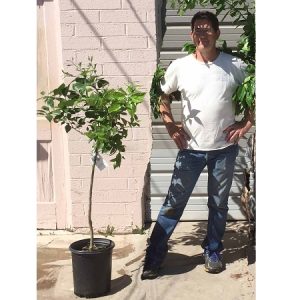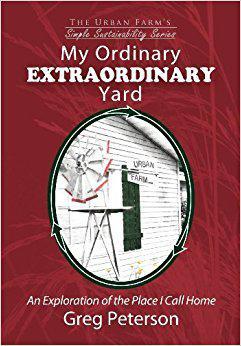Are You Overpaying for your fruit trees?
by Farmer Greg Peterson
How much should you be paying for your fruit trees?
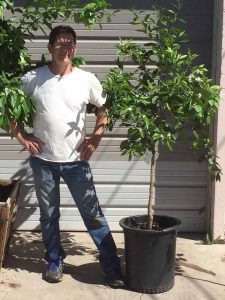
Greg standing near a #15 or 15 gallon citrus tree
That is really a good question. I’ve been playing with and planting fruit trees since 1974 in the low desert, so I have seen a lot! Recently Janis and I got a crazy impulse and decided to survey the local nurseries in the Valley to see what their pricing was for fruit trees and boy did we get a shock! I will let you make your own phone calls to see what you can find, but the average price that we found was almost 3 times what we sell our trees for.
But before we go any further on that topic, here are some key things that you need to know to ascertain whether the price you are paying is an appropriate price for the tree that you are looking to purchase.
Setting aside whether you are getting a fruit tree that will actually make fruit in the low desert (we cover this in a class called “What you need to know before you buy your fruit trees”), there are a few key things you need in order to decipher if what you’re looking to spend is a “good” price or a “hold-on-I-shouldn’t-be-paying-that-much-for-that-tree” price.
So before you spend a dime on trees, I highly suggest reading this article and maybe even do some of your own calling around about pricing and asking these other key questions.
Things to know before you buy!
- Potted vs Bare Root – Citrus trees always come potted or in B&B (essentially a burlap pot). Deciduous trees (in this case we are talking about peaches, apricots, apples, plums, figs, mulberries, berries, grapes and more) can come either as potted or as bare root (dug up out of the ground with no dirt around their roots.)

Greg standing near a #5 or 5-gallon citrus tree
Pot Size – let’s talk about how nurseries and big box stores sell fruit trees. They are generally sold by what is called pot size. You may have heard of 5-gallon or 15-gallon pots, but the nursery business is transitioning to calling them #5’s and #15’s (or any number between 1 and 15).
Here is the tricky piece on this one. It is very easy for a nursery to purchase a #5 size plant and put it in a #15 size pot, then sell it for the #15 price without giving it time to grow into the bigger container. So, you really can’t count on a nursery telling you that a #15 tree is a #15 size. I recently saw a nursery buying #15 trees and putting them in 24-inch boxes and selling them for that bigger price right away. I have seen this done with both citrus and deciduous trees.
The true determining factor in size should be the caliper width of the trunk, which tells you how old the tree should be. However, some trees grow faster than others, so this measurement depends on the variety.
- Bare Root is a term that is applied to deciduous trees, as they go dormant in the winter and can be dug up when they are asleep. Most of the big growers, including Dave Wilson who we purchase from, dig up the trees while they’re dormant and ship them without any dirt around their roots (hence bare root).
Most bare root fruit trees for Arizona are shipped dormant from California in a 4–6-week period in December and early January. The Urban Farm Fruit Tree program provides bare root trees to our members during the second half of January to be picked up at our pop-up nursery.
The key piece about this, is that the trees arrive dormant, and you take them home dormant. When you pick them up, it is your responsibility to immediately get them planted into the ground. Hence our extensive education program starting in September to get you up to speed on everything you need to know in order to be successful.
With bare root trees you need to have the holes dug and ready for receiving the trees when you pick them up so that you can immediately take them home and plant them. I know, I know, I’m being a little repetitive here!
- Most nurseries receive fruit trees at the same time that the Urban Farm Nursery does, from the same growers, for the same wholesale price. The key thing to know here is that growers have a standard wholesale price list that everybody pays. So, The Urban Farm Nursery is paying virtually the same thing that other nurseries are paying.
Then the other nurseries pot the bare root trees up in a #5 or a #15 pot and make them available for you to pick up over the next few months. The downside of doing it this way is the trees break the dormancy in the pot. You come along in February or March and purchase the tree which hasn’t had enough opportunity to really get well rooted into the pot. You take it home, take it out of the pot, all the soil and roots can fall away and that poor tree has to start growing its new roots all over again. And besides slowing down the growth, with the roots falling off, this process puts the tree into a stressed cycle.
This is one of the big reasons we like to offer bare root. You pick up the tree when it’s dormant. It’s been dormant since they harvested it a month earlier. You take it home and put it in the ground while it is dormant or just barely waking up, and it breaks dormancy where it’s going to live the rest of its life.
All right, now that we’ve reviewed all of the above, what is the single biggest indicator of the price you should pay?
The answer is the diameter of the trunk at about 4 inches above the ground, this is called the caliper size!
- Citrus can range from a teeny base diameter to 4 inches. Generally speaking, a #5 citrus is 1/4 inch to 5/8 inch diameter. A #15 citrus can be between 3/4 inch and 1.5 inches base diameter. A 24-inch boxed citrus should generally be between 1.5 inches and 4 inches base diameter. Remember, these are just estimates AND they’re here to give you a general idea of the value of the tree.
- Deciduous fruit trees include apples, apricots, peaches, plums, jujubes and mulberries. A #5 size deciduous tree should generally be around ½ inch base diameter, and a #15 should be generally around ¾ of an inch to 1 ½ inches.
- Then there are the small potted deciduous trees. This includes figs, olives, grapes, berries, mulberries and pomegranates. These are harder to define on the trunk size as they often are just growing out of the pot with a strong root system. Generally speaking, they come in a #1 or a grower’s pot (4”x4”x9”) and can be 18 inches to 3 feet tall in the pot.
There are two primary growers of fruit trees that sell into the Arizona market.
There are other growers, but these are the primary places where most Valley nurseries get their trees.
- Sunset Citrus Nursery in Yuma provides a vast majority of citrus to Arizona and are the ONLY wholesale commercial grower in the state. It is VERY hard to get permits to bring citrus into the state, making Sunset the main citrus grower in the state. In visiting every retail nursery in the valley, they all have purchased from Sunset – I can identify them from the tree tags (so can you!)
- Dave Wilson Nursery, out of northern California, is one of the largest fruit, nut, and shade tree growers in the country. They have streamlined the growing and delivery process to make it easy for nurseries to buy from them.
The curious thing about both Sunset and Dave Wilson is that they have a price list that they use for all their buyers. In other words, we pay virtually the same that everyone pays….hmmm. Remember that when you are calling around and getting pricing from nurseries.
Questions to ask:
- Are these trees proven to actually produce here in the low desert?
See our What You Need to Know Before You Buy class. There are multiple things to be aware of; chill hours, ripening times, root stock, and variety. While some apples are low chill enough to produce in the desert, they ripen in the fall and the fruit has to struggle through the summer. While many of these trees will produce a few pounds – you have to ask yourself is it worth it.
- What is the diameter of the trunk 6-inches above the ground?
- How long has the tree been in this pot?
We hope this helps.
About this author:
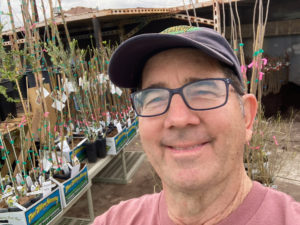
Greg Peterson
Founder,
Urban Farm Nursery & Urban Farm U
Farmer Greg has been digging his toes into the earth, listening to the plants, and experimenting with progressive permaculture techniques in his yard for over 40 years. His 1/3-acre home in Phoenix, AZ has been converted into an entirely edible landscape which he periodically opens to the community for tours and classes, and his Fruit Tree Program has resulted in the planting of over 10,000 fruit trees. Greg’s passion is seeing others discover that they can grow food successfully, and his mission is to show that they too can realize the power, joy and deliciousness of urban farming!
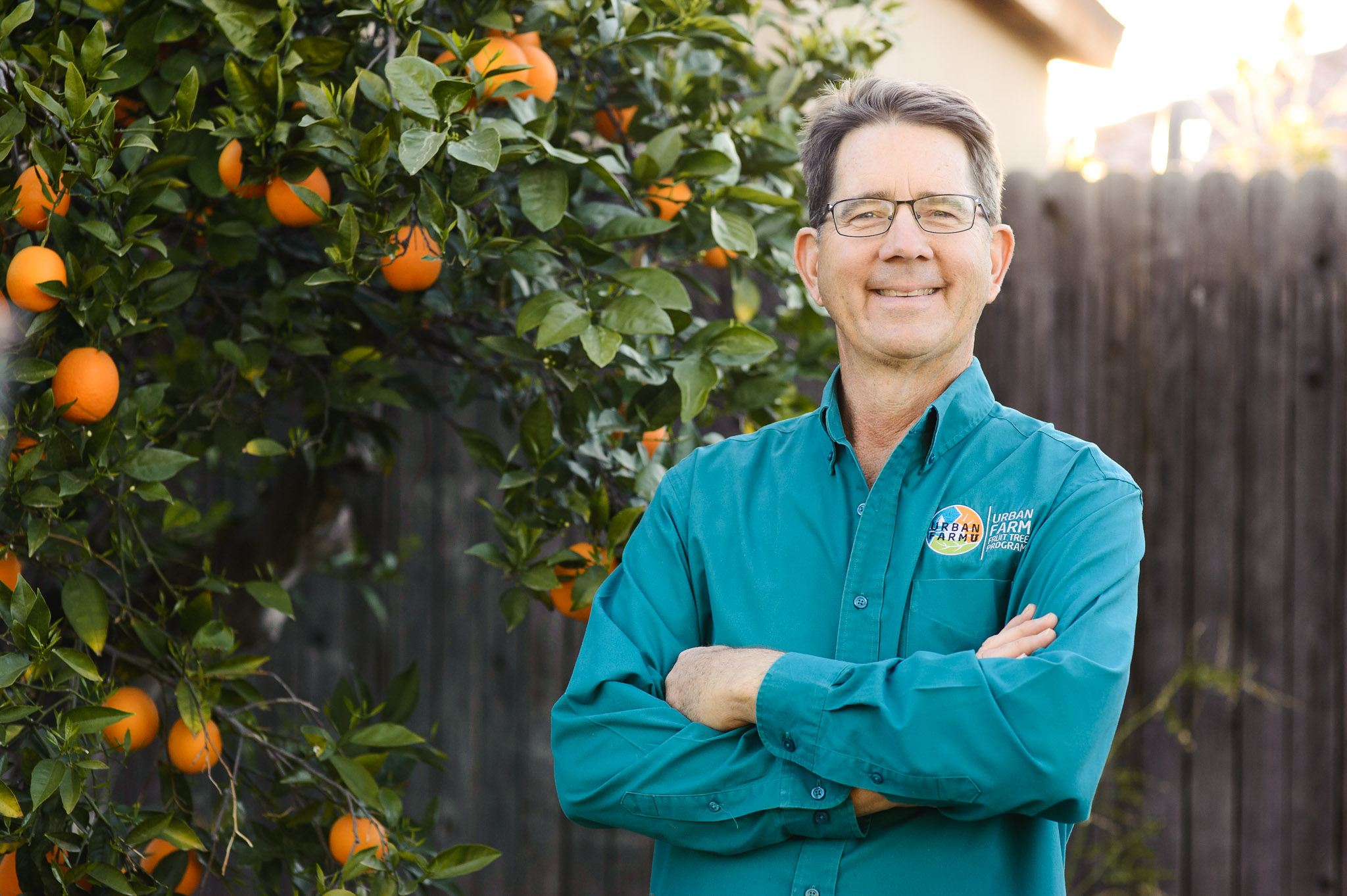
Are you local to Greater Phoenix and want Fruit Trees?
Check out the Urban Farm Fruit Tree Program. A comprehensive education program combined with a Pop-Up Nursery for Fruit Trees. Learn more by going to FruitTrees.org or clicking HERE


